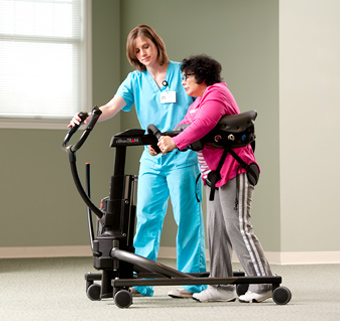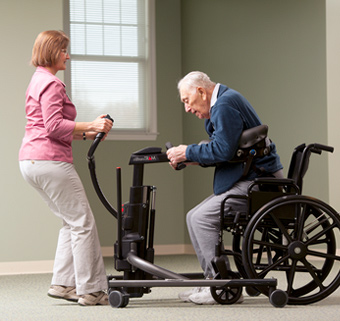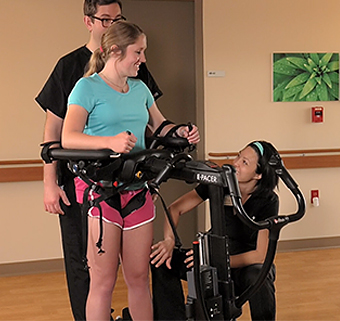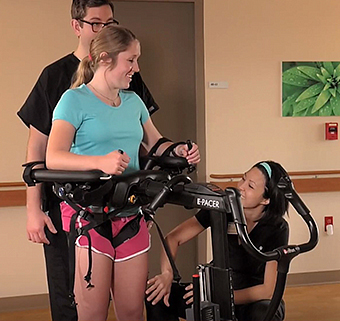Improving Functional Mobility in Home Care
| September 2014 As a physical therapist in the home care setting, I am always looking for new and innovative ways to improve a patient’s ability to perform functional mobility and activities of daily living (ADL). Improving mobility and ADL performance helps prevent bodily deterioration, reduces caregiver stress, and enables the patient to stay at home longer before requiring institutionalized care.
As a physical therapist in the home care setting, I am always looking for new and innovative ways to improve a patient’s ability to perform functional mobility and activities of daily living (ADL). Improving mobility and ADL performance helps prevent bodily deterioration, reduces caregiver stress, and enables the patient to stay at home longer before requiring institutionalized care.
One of my most effective tools is also one of the simplest: teaching a stand-pivot transfer, a crucial skill for maintaining quality of life. In my practice I have become convinced that many home care patients who have become deconditioned following hospitalizations have the potential to regain their ability to perform a stand-pivot transfer. But too often they’re not given the opportunity.
Maintaining Quality of Life with a Stand-Pivot Transfer
The stand-pivot transfer requires leg strength, trunk control, and a measure of balance and stability. With minimal or moderate assistance of a family member or home health aide, an individual can move from the bed to a wheelchair or from a wheelchair to the toilet without the use of a conventional sling-type (Hoyer®) lift. Having the ability to perform this simple transfer maintains continued participation in family activities and community events. Once a patient can no longer perform these weight-bearing transitions, they often become dependent and bedridden. These are the people who can no longer utilize the toilet or commode and are forced to return to bed to use a bedpan. Not being able to use a toilet or commode severely restricts quality of life. They are also at risk for not being able to safely remain in their homes without a significant amount of assistance which is both costly and usually unavailable. And that’s why I’ve become a strong proponent of improving leg and core strength. Without these, patients have difficulty rolling over in bed, sitting up and doing transitions from sit to stand.
(As a side note, I was excited to learn of a court decision last year stating that Medicare can no longer use the notion of “continuous improvement” to place a limit on home care PT visits. Jimmo v. Sebelius established that skilled physical therapy intervention is important to maintain an individual at their maximum level of function. And if a patient does not show potential for further restoration and progress, physical therapy and home health care are still appropriate as this may keep beneficiaries out of more expensive institutions.)
What disappoints me acutely is when a therapist will look at a home care patient who has been using a Hoyer®following a hospitalization, or even multiple hospitalizations, just shrug her shoulders and consign them to this for the remainder of their life. Perhaps they don’t realize that with pro-active and innovative therapy intervention, a patient’s ability to do a stand-pivot transfer can return. I’m passionate about this because I have seen this functional motor skill improve and return, even with a patient who’d been using a Hoyer® for as much as three years.
A Mobility Aid for Stand-Pivot Transfers
 So what’s my secret? The Rifton TRAM. I discovered this product and found that it fills a critical gap in recovery and rehab in the home care setting. The TRAM is an innovative transfer and mobility device that is ideal for developing leg strength during gait training sessions in the home. The TRAM fully and safely supports my patients so they can’t fall. This takes the strain off the therapist trying to lift or support the patient. And patients feel secure. Using the TRAM they are certainly more confident and display less anxiety than when attempting gait training with a minimally supportive rolling walker. With the TRAM, I’ve seen patients progress from dependence on a Hoyer® to being able to do stand-pivot transfers and even walk again with a rolling walker.
So what’s my secret? The Rifton TRAM. I discovered this product and found that it fills a critical gap in recovery and rehab in the home care setting. The TRAM is an innovative transfer and mobility device that is ideal for developing leg strength during gait training sessions in the home. The TRAM fully and safely supports my patients so they can’t fall. This takes the strain off the therapist trying to lift or support the patient. And patients feel secure. Using the TRAM they are certainly more confident and display less anxiety than when attempting gait training with a minimally supportive rolling walker. With the TRAM, I’ve seen patients progress from dependence on a Hoyer® to being able to do stand-pivot transfers and even walk again with a rolling walker.
The TRAM’s small footprint, (27 ½” width, 45 ½” length) makes it easy to work with in a confined living room space. As a patient learns to take steps with the support of the TRAM, I find that you only need 8 or 10 feet to walk forward. Then take several steps backward, and go forward again.
Not only that, but the TRAM has a built-in scale which measures the amount of weight bearing during gait practice. This serves as an objective measure to show continuous improvement. The insurance people always love to see that.
And the TRAM is transportable. Because it fits into my minivan and is easy to lift with just two adults, I bring it around with me on my home care visits. If two adults are not available for lifting, I’d recommend obtaining an aluminum loading ramp at Home Depot.
Success Stories Using the Rifton TRAM
Perhaps I could best convey my enthusiasm for the TRAM by sharing two patient stories:
The first patient is a motivated and cooperative 80-year-old lady with Multiple Sclerosis. She lives with her husband at home and is determined to remain there. They’ve arranged for renovations to the bathroom to make this possible.
However, after significant medical issues resulting in a series of hospitalizations, she became very weak and lost her ability to perform a stand-pivot transfer. They ended up using a Hoyer® lift for all transfers and she began spending more time in bed than was healthy for her both physically and emotionally.
When she was medically stabilized and starting physical therapy, she had not done a stand-pivot transfer for a year. But together with my colleague, Meg Povroznik, OT, and the support of the TRAM, gait training was possible. With the walking saddle positioned underneath, the TRAM easily assisted her in a sit to stand transfer. Unlike the Hoyer®, the unique design of the TRAM allowed her feet to remain firmly on the floor during the transfer to the upright position. Meg then guided the TRAM forward while I was behind helping our patient with knee extension of the stance limb, weight shifting and stepping. It was fabulous. In three weeks, her weight bearing and stability had improved to the point where she could, with the assistance of two, stand up and walk eight feet forward with a standard rolling walker. Her stand-pivot transfers could be done with assistance of one individual and stand-by assist of a second. It was amazing.
The second patient is a dynamic 60-year-old lady with an incomplete spinal cord injury from a motor vehicle accident. After a year of extensive rehab, she was just beginning to functionally take steps in the home environment when a tumor causing cord compression was discovered near her spine. Although this was surgically removed, she never regained the strength in her legs.
Determined to make progress, she admitted herself to an inpatient rehab facility for a short stay during which she was able to use a standing frame. Upon discharge home, she could maintain a standing position for only 30-45 seconds with continued assistance and required two or three adults to manually lift her up from her power lift chair. She had been otherwise using a Hoyer® for the last three years.
Here again, we decided to use the TRAM. However, one day she was feeling too tired for a gait training session with the TRAM so I decided to attempt a stand-pivot transfer from her wheelchair to the bed in order to do exercises in bed. She performed that transfer and then again after bed exercises as well. I knew this was only possible secondary to the rehabilitation progress she had made initially with the TRAM.
Her current goal is to return to work as she still has a lot to contribute to society. This means working towards performing stand-pivot transfers in a handicapped accessible bathroom. Improving leg strength and core strength with use of the TRAM is a huge step towards this goal. At our next session, we will attempt a stand-pivot transfer from her wheelchair to a shower tub bench for the first time.
Future Potential of the Rifton TRAM
Overall, use of the TRAM requires my patients to work through the preliminary steps of moving in bed from the supine to the sitting position. Incorporating these steps into the therapy session is a huge advantage in terms of repeated practice of functional bed mobility for increased trunk strength. When the patient is seated on the edge of the bed with the TRAM in front, I require them to move to the edge of the bed, lean forward and reach for the handholds to pull themselves into the TRAM. With just these simple steps, I have seen remarkable improvement in trunk control.
Over time, this can mean that my patients can have the walking saddle placed under them with no prior lifting. With sufficient trunk strength, a patient can weight shift, lifting one buttock at a time while I position the TRAM’s walking saddle underneath.
Currently we’re seeing significant growth in the home care practice area due to a rapidly aging population. Practitioners performing routine home visits need to be on the alert for interventions, products and supports that will help to keep people in their own homes for as long as they desire and out of more costly institutional care settings. From my experience, I have found the Rifton TRAM to be an innovative product that meets this growing need. To date, there are still functions of the Rifton TRAM I am discovering and I know I will continue to make discoveries about its potential in home care.




